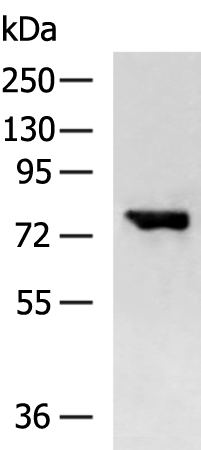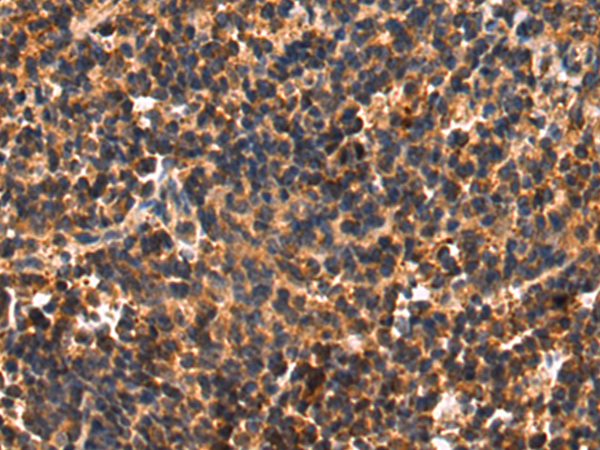

| WB | 咨询技术 | Human,Mouse,Rat |
| IF | 咨询技术 | Human,Mouse,Rat |
| IHC | 1/50-1/200 | Human,Mouse,Rat |
| ICC | 技术咨询 | Human,Mouse,Rat |
| FCM | 咨询技术 | Human,Mouse,Rat |
| Elisa | 1/5000-1/10000 | Human,Mouse,Rat |
| Aliases | PAL |
| WB Predicted band size | 76 kDa |
| Host/Isotype | Rabbit IgG |
| Antibody Type | Primary antibody |
| Storage | Store at 4°C short term. Aliquot and store at -20°C long term. Avoid freeze/thaw cycles. |
| Species Reactivity | Human |
| Immunogen | Fusion protein of human SHCBP1 |
| Formulation | Purified antibody in PBS with 0.05% sodium azide and 50% glycerol. |
+ +
以下是关于SHCBP1抗体的3篇参考文献,按格式整理如下:
---
1. **文献名称**:*SHCBP1 promotes tumor cell proliferation and migration in colorectal cancer via stabilizing EGFR*
**作者**:Li Y, et al.
**摘要**:该研究利用SHCBP1抗体进行Western blot和免疫组化分析,发现SHCBP1在结直肠癌组织中高表达,并通过稳定EGFR蛋白促进肿瘤增殖和转移,提示其作为潜在治疗靶点。
2. **文献名称**:*SHCBP1 regulates mitotic progression in hepatocellular carcinoma through interaction with PLK1*
**作者**:Zhang Q, et al.
**摘要**:通过SHCBP1抗体的免疫荧光染色,研究者发现SHCBP1与PLK1相互作用,调控肝癌细胞有丝分裂进程,其表达异常导致染色体不稳定和肿瘤恶化。
3. **文献名称**:*High expression of SHCBP1 correlates with poor prognosis in gastric cancer*
**作者**:Wang H, et al.
**摘要**:该研究使用SHCBP1抗体对胃癌组织进行免疫组化评分,发现SHCBP1高表达与患者生存期缩短显著相关,并验证其通过激活MAPK信号通路驱动肿瘤进展。
---
以上文献均明确提及SHCBP1抗体的应用(如Western blot、免疫组化或免疫荧光),并聚焦于SHCBP1在肿瘤中的功能机制及临床意义。如需更多文献或具体期刊信息,可进一步补充关键词检索。
SHCBP1 (SHC SH2 Domain-Binding Protein 1) is a protein encoded by the SHCBP1 gene, which belongs to the SHC (Src Homology 2 Domain-Containing) family. This protein interacts with the SH2 domain of SHC1. a key adaptor molecule in growth factor receptor signaling pathways. SHCBP1 is implicated in regulating cell cycle progression, particularly during mitosis, and plays a role in chromosomal segregation and spindle assembly. Studies highlight its involvement in cellular proliferation, differentiation, and apoptosis, with dysregulation linked to various cancers, including breast, gastric, and colorectal cancers, where its overexpression often correlates with poor prognosis.
SHCBP1 antibodies are essential tools for investigating its biological functions and pathological roles. These antibodies are widely used in techniques like Western blotting, immunohistochemistry (IHC), and immunofluorescence (IF) to detect SHCBP1 expression levels, subcellular localization, and interaction partners. Research utilizing SHCBP1 antibodies has revealed its association with tumorigenesis, including promoting cancer cell proliferation, invasion, and metastasis. Additionally, SHCBP1 antibodies help explore its potential as a diagnostic biomarker or therapeutic target. Validation of antibody specificity, often through knockout or knockdown models, ensures reliable detection in both physiological and disease contexts, advancing understanding of SHCBP1's molecular mechanisms in health and cancer.
×